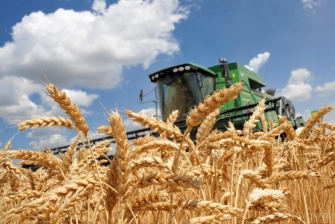Додатковий матеріал для студентів аграрних коледжів по темі: "Agriculture"

Agriculture is a human activity.
- Read the text and translate.
Agriculture is an important economic activity. It includes growing crops and rearing animals. Agriculture produces a wide range of products for manufacturing industries as well as food. Unlike manufacturing and services, agriculture relies heavily on the pollution of the environment, especially climate, and the life cycles of plant and animals. Both are largely outside the control of farmers. Agriculture also uses a larger proportion of the Earth's surface (about 37 per cent of the land area) and provides more employment world wide than any other economic activity. Factors involved in land use. The way in which people use their land and organize their agricultural activities varies greatly. Physical, economic and human factors all exert an influence upon agriculture, although the importance of each varies from place to place. These factors are also interrelated. At the global scale the distribution of agriculture is most influenced by climate. Large parts of the planet are unsuitable for farming because they are either too cold 6 or too dry. All crops have minimum requirements for heat. Growth usually begins when the daily air temperature rises above 6°C. Moreover, temperatures have to be above this critical level for at least 120 days. As you go nearer to the poles, temperatures fall and the growing season shorten, until cultivation is impossible. This is the main reason why cultivation rarely extends beyond latitude 60° in the northern hemisphere. Crops also have minimum moisture requirements. The world's hot deserts, such as the Saharan, Arabian and Australian deserts, are too dry for cultivation unless water is available for irrigation. High mountains such as the Himalayas and Andes support few farming activities. As well as severe climates they also have steep slopes and thin soils. In the more developed countries of the world, where scientific knowledge is applied to farming, economic and human factors tend to play a particularly important role. Physical problems can, to some extent, be overcome. In Holland, for example, a lot of the present farming land has in fact been reclaimed from beneath the sea. In Australia, water from the Snowy river has been diverted to irrigate land in the southeastern Australia, so making it possible to increase crop fields there. In Canada and the USA scientific plant rearing has made it possible to extend the cultivation of wheat into areas which were previously thought to have been too dry or too cold.
- Vocabulary:
pollution – забруднення
the Earth’s surface – поверхня Землі
interrelated – взаємопов‘язані
unsuitable – непридатна
requirements for heat – температурна межа
moisture requirements – фактори вологості
cultivation – культивація
beyond the latitude –за широту
hemisphere – півкуля
irrigation – зрошення
steep slopes – стрімкі схили
thin soils – бідні ґрунти
to some extent – в деякій мірі
plant rearing –вирощування рослин
wheat – пшениця
- Translate the following words and phrases into English:
вирощування рослин і розведення тварин, різноманітний ряд продуктів, залежати від забруднення середовища, надавати більше робочих місць, відрізнятися способом організації с/г, розподіл с/г на земній кулі, обробіток землі, наявний для зрошення, розвинені країни, зрошувати землю, збільшити території під посіви.
- Translate the following noun + noun combinations and find them in the text.
Pest control, food production, land degradation, soil erosion, nutrient depletion, soil fertility, wind erosion, water erosion, crop production.
- Explain the meaning of the following words and phrases in English and find them in the text:
agriculture, pollution of the environment, cultivation, irrigation, requirements for heat, moisture requirements.
- Please retell the text close to the original.


про публікацію авторської розробки
Додати розробку
